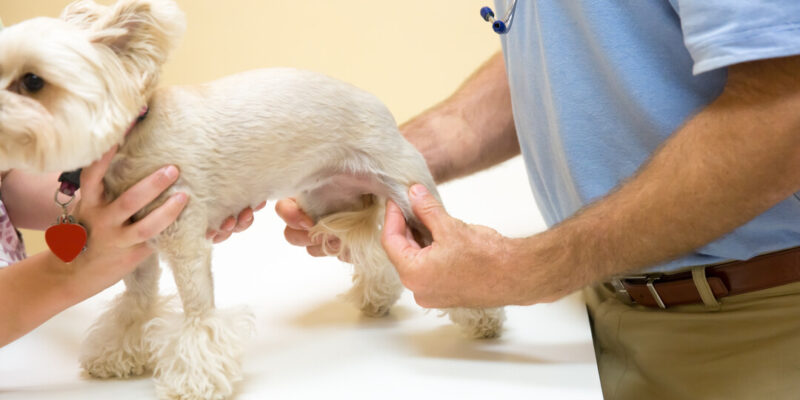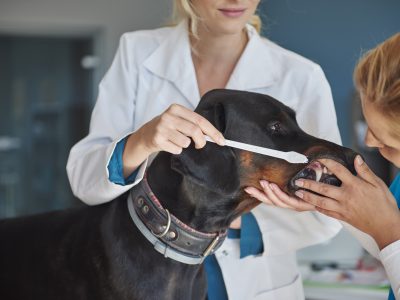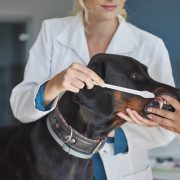In dogs, luxating patella, also known as a “trick knee”, is a condition where the kneecap dislocates from its normal position. The kneecap or patella sits in a groove at the end of the femur. When the patella or knee cap luxates, it moves out of this groove and causes pain and lameness. The dislocation of patella can be mild to severe and is a common orthopedic abnormality in dogs. If your dog is in serious discomfort, its best to take them to animal hospital Virginia Beach.
A study in the Journal of Veterinary Internal Medicine found that 7% of dogs are affected, with small breeds more prone.
Importance of Understanding the Condition
Since luxating patella hampers the mobility, it has a significant effect on the dog’s quality of life. Thus, it’s essential that you understand what luxating patella is and how to recognize if your dog has it. As with most other ailments, early detection and appropriate management can improve the prognosis and ease the discomfort.
Common Breeds Affected
According to Veterinary Clinics of North America the condition is most common in breeds such as Pomeranians, Yorkshire Terriers, Poodles, Chihuahuas and Boston Terriers with prevalence rates ranging from 5-7% in these breeds.
Common breeds include:
- Pomeranians
- Yorkshire Terriers
- Poodles
- Chihuahuas
- Boston Terriers
According to American Kennel Club (AKC), luxating patella is one of the top three orthopedic issues found in small breed dogs.
How to Recognize the Symptoms of Luxating Patella
- Early Signs to Watch For
A survey by the American Veterinary Medical Association (AVMA) reported that 67% of dog owners noticed intermittent limping as the first sign of a luxating patella.
If you have a small breed dog or planning to bring one into your life, you must be vigilant of their mobility. While early symptoms of patella luxation are subtle, you can easily detect them. Some signs to look for include intermittent limping or skipping on one leg.
You might notice that your dog is occasionally holding up a hind leg or experiencing sudden bouts of lameness.
- Progressive Symptoms
As the condition progresses, the symptoms become more pronounced. Dogs may exhibit:
- Persistent limping
- Difficulty walking or running
- Reluctance to climb stairs or jump
- Noticeable pain when the knee is manipulated
Impact on Dog’s Daily Life
A luxating patella can significantly affect a dog’s daily activities. They may struggle with basic movements, exhibit decreased enthusiasm for play, and show signs of discomfort or pain during regular activities.
Diagnosis of Luxating Patella
- Veterinary Examination Techniques
Veterinarians throughout animal hospitals in Virginia Beach use a combination of physical examinations and history-taking to diagnose luxating patella. They palpate the knee joint to feel for instability and assess the range of motion.
The grading system is widely used by veterinarians, with Grade 1 being the mildest form and Grade 4 the most severe. A study in the Journal of the American Animal Hospital Association found that 50% of cases diagnosed are Grade 2, which can often be managed without surgery
- Diagnostic Imaging Tools
Imaging techniques such as X-rays and ultrasounds are commonly used to confirm the diagnosis and assess the severity. These tools help in visualizing the displacement of the patella and any associated abnormalities in the joint structure.
- Grading System of Luxating Patella
The condition is typically graded on a scale from 1 to 4:
- Grade 1: The patella can be manually luxated but returns to its normal position when released.
- Grade 2: The patella luxates with manual pressure or during movement but returns to normal position spontaneously.
- Grade 3: The patella is often luxated and can be returned to the groove manually.
- Grade 4: The patella is permanently luxated and cannot be manually repositioned.
Treatment Options for Luxating Patella
Non-Surgical Interventions
- Physical Therapy
Physical therapy can help strengthen the muscles around the knee, improving stability and reducing luxation episodes. Exercises may include controlled walking, swimming, and specific strengthening routines.
The American College of Veterinary Surgeons (ACVS) suggests that physical therapy can improve outcomes in 70% of dogs with mild to moderate luxating patella.
- Weight Management
Maintaining an optimal weight is essential to reduce stress on the knee joint. Overweight dogs are more likely to experience severe symptoms and complications.
A study in the Journal of Veterinary Surgery found that 30% of dogs with luxating patella showed improvement in symptoms with weight management alone.
- Pain Management
Pain management strategies include anti-inflammatory medications, pain relievers, and natural supplements like glucosamine and chondroitin to support joint health.
According to the Canine Health Foundation, 50% of dogs with luxating patella benefit from anti-inflammatory medications and joint supplements.
- Supplements
Joint supplements can provide additional support. Omega-3 fatty acids, glucosamine, and chondroitin are commonly recommended to promote joint health and reduce inflammation.
Surgical Interventions
Types of Surgeries
There are several surgical options to correct luxating patella, including:
- Tibial Tuberosity Transposition (TTT): Realigns the kneecap by repositioning the tibial crest.
The American Animal Hospital Association (AAHA) reports that surgeries like Tibial Tuberosity Transposition (TTT) and Trochleoplasty have a success rate of 85-90% in reducing symptoms and improving mobility. - Trochleoplasty: Deepens the groove where the patella sits.
- Medial Release: Releases tight tissues on the inside of the knee to allow proper patella alignment.
Pre-Operative Preparations
Pre-surgery preparations include a thorough veterinary examination, blood tests, and imaging to plan the surgery accurately.
Post-Operative Care
Post-operative care is critical for a successful recovery. It includes restricted activity, physical therapy, and regular follow-up visits to the vet.
The Journal of Small Animal Practice indicates that 80% of dogs undergoing surgery for luxating patella have a successful recovery with appropriate post-operative care.
Regular check-ups allow the vet to monitor the dog’s progress, adjust treatment plans, and catch any signs of recurrence early. Consistent veterinary care is vital for managing luxating patella effectively.












Comments